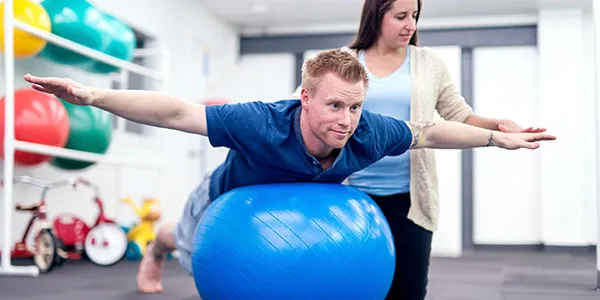
Physical therapy is a vital component of healthcare, playing a crucial role in the recovery process for individuals dealing with various injuries and conditions. With its wide range of benefits, including pain management, improved mobility, and enhanced strength, physical therapy offers hope and healing to those in need. From specialized techniques tailored to specific conditions to incorporating exercise and nutrition into treatment plans, physical therapy provides a holistic approach to rehabilitation. Whether it's recovering from sports injuries, post-surgery rehabilitation, or managing chronic pain, physical therapy offers personalized care to address each individual's unique needs. With advancements in technology and innovative treatment options, the field of physical therapy continues to evolve, providing patients with cutting-edge solutions for their recovery journey. By setting realistic therapy goals, finding qualified therapists, and incorporating home exercises, individuals can take an active role in their healing process and measure their progress along the way. As we delve into the world of physical therapy, we will explore its impact on recovery, the importance of choosing the right program, and the various aspects that contribute to successful rehabilitation.
Physical therapy plays a crucial role in healthcare by helping individuals recover from injuries, manage chronic conditions, and improve mobility. One of the key benefits is that it can reduce pain and inflammation, leading to improved overall function and quality of life for patients. The personalized nature of physical therapy treatment allows for tailored interventions to address each individual’s specific needs.
There are various types of physical therapy techniques used depending on the patient's condition and goals. These may include manual therapies such as massage or joint mobilization, therapeutic exercises to strengthen muscles and improve flexibility, as well as modalities like heat or cold therapy. By incorporating these different approaches, physical therapists can effectively help patients regain strength and functionality.
The importance of physical therapy in recovery cannot be understated. It not only aids in the rehabilitation process but also educates patients on how they can prevent future injuries or manage their condition independently. Additionally, physical therapists work closely with other healthcare professionals to ensure a comprehensive approach to care for their patients.
When selecting a physical therapy program, it is crucial to find a qualified physical therapist who has expertise in your specific condition or injury. A good place to start is by asking for recommendations from your healthcare provider or friends and family who have had positive experiences with a particular therapist.
Understanding the different treatment approaches available can also guide you in choosing the right physical therapy program. Some therapists may focus on manual therapy techniques, while others may incorporate more exercise-based interventions. It's essential to discuss these approaches with potential therapists and determine which aligns best with your needs and goals.
Setting realistic therapy goals is another important factor when choosing the right program for you. A good therapist will work with you to establish achievable milestones throughout your treatment process, helping to keep you motivated and on track towards recovery.

Physical therapy plays a crucial role in the rehabilitation process, especially for individuals recovering from sports injuries. Through targeted exercises and techniques, physical therapists help patients regain strength, flexibility, and mobility in the affected areas. The personalized approach of physical therapy ensures that each patient's specific needs and goals are addressed, leading to a more effective recovery.
Post-surgery rehabilitation often involves physical therapy to aid in the healing process and restore normal function. Whether it's joint replacement surgery or some other procedure, physical therapists create customized treatment plans to facilitate recovery. By incorporating various therapeutic interventions, such as manual therapy and specialized exercises, they support patients in regaining their pre-surgery level of activity.
For individuals managing chronic pain conditions, physical therapy offers non-invasive methods to alleviate discomfort and improve overall well-being. Through carefully designed exercises and modalities like heat/cold therapy or ultrasound, patients can experience relief from pain while working towards long-term management strategies. The holistic approach of physical therapy addresses not only the symptoms but also focuses on preventing future issues.
Physical therapy plays a crucial role in treating back and neck pain. With the use of various techniques such as manual therapy, therapeutic exercises, and modalities like ultrasound or electrical stimulation, physical therapists aim to reduce pain, improve movement, and restore function. By customizing treatment plans to each individual's needs, physical therapy helps patients regain strength and mobility while preventing future recurrences of discomfort.
Rehabilitation after a stroke often involves physical therapy to help patients regain lost motor function and mobility. Physical therapists work with stroke survivors to address muscle weakness, coordination issues, balance problems, and difficulty walking. Through targeted exercises and interventions tailored to each person's specific challenges, physical therapy aims at maximizing recovery potential following a stroke event.
For individuals dealing with musculoskeletal disorders such as osteoarthritis or tendonitis, physical therapy offers non-invasive options for managing pain and improving joint flexibility. Therapists can provide education on proper body mechanics and posture while utilizing therapeutic techniques like stretching exercises or manual manipulation. By addressing underlying biomechanical imbalances through personalized treatment plans, physical therapy promotes long-term relief from musculoskeletal discomfort.

Physical therapy often incorporates customized exercise programs to address the specific needs of the patient. These programs are designed to improve strength, flexibility, and overall function. By tailoring exercises to the individual, physical therapists can help patients progress in their recovery and achieve optimal results.
Therapeutic exercises offered in physical therapy provide a wide range of benefits, including improved mobility, increased endurance, and reduced pain. These exercises not only target the affected area but also work on surrounding muscles and joints. The goal is to restore normal movement patterns and prevent further complications or re-injury.
Furthermore, integrating exercise into physical therapy plays a key role in preventing future injuries. Patients learn proper techniques for movements and gain an understanding of how to maintain their progress outside of treatment sessions. This proactive approach helps individuals stay active while reducing the risk of recurring issues.
Home exercises are an essential component of physical therapy treatment. These exercises provide patients with the opportunity to continue their recovery progress outside of the clinic, allowing them to maintain and build upon the gains made during in-person sessions.
Following guidelines for home exercise routines is crucial to ensure that patients are performing the appropriate movements and activities. Consistency and proper form are key factors in promoting optimal recovery, and physical therapists carefully design these routines to meet each patient's specific needs.
Monitoring progress at home allows therapists to track a patient's improvement, adjust their exercise program as needed, and provide additional guidance or support when necessary. By adhering to prescribed home exercises, patients can accelerate their recovery process while also gaining confidence in managing their condition independently.
Nutritional support plays a crucial role in the success of physical therapy treatment. A well-balanced diet can provide essential nutrients that aid in recovery and promote healing. For individuals undergoing rehabilitation, nutrition can help optimize the body's ability to repair tissues, reduce inflammation, and improve overall physical function.
When designing a dietary plan for those undergoing physical therapy, it is important to consider specific nutritional needs based on the individual's condition and treatment goals. This may include focusing on high-protein foods to support muscle recovery, incorporating anti-inflammatory foods to reduce pain and swelling, as well as ensuring adequate intake of vitamins and minerals necessary for tissue regeneration.
By addressing nutritional aspects alongside physical therapy exercises and treatments, healthcare professionals can enhance the overall effectiveness of rehabilitation programs. Proper nutrition not only supports the body's ability to recover from injury or illness but also contributes to better outcomes in terms of strength building, mobility improvement, and long-term health maintenance.
Advancements in therapeutic equipment have revolutionized the way physical therapy is administered. From state-of-the-art resistance machines to advanced ultrasound and electrical stimulation devices, these innovations have provided therapists with more effective tools to aid in patient recovery.
Telehealth options for physical therapy have also become increasingly popular, especially in light of recent events that have limited access to traditional clinic visits. Through virtual consultations and remote monitoring, patients can continue their rehabilitation from the comfort of their own homes.
Furthermore, the integration of virtual reality in rehabilitation has opened up new possibilities for engaging patients in their exercises and activities. By creating immersive environments that simulate real-life movements and scenarios, VR has shown promising results in improving both physical function and psychological well-being during recovery.
One way to measure success in physical therapy is by tracking the progress and outcomes of patients. This can be done through documentation of functional improvements, pain reduction, and increased range of motion. By comparing initial assessments to current abilities, therapists can determine the effectiveness of the treatment plan and make necessary adjustments for optimal results.
Patient satisfaction and feedback also play a vital role in evaluating the success of physical therapy. Understanding the patient's experience, goals achieved, as well as any challenges faced during treatment provides valuable insight into the overall effectiveness of the therapy services. It also helps in identifying areas for improvement and enhancing patient-centred care.
Lastly, measuring success in physical therapy involves recognizing its long-term benefits. Beyond just short-term relief from pain or injury, successful physical therapy contributes to improved quality of life and reduced risk for future injuries. Longitudinal studies have shown that individuals who undergo proper physical therapy treatment are less likely to experience recurrent issues related to their initial condition.
At Prime Chiro, we understand the importance of finding the best chiropractor near you in Lansvale NSW and surrounding areas like Fairfield, Liverpool, and Cabramatta. Our team of experienced professionals is dedicated to providing top-quality chiropractic care and consultation services to help individuals find relief from pain and improve their overall well-being. Whether you are suffering from back pain, neck pain, headaches, or other musculoskeletal issues, our personalized treatment plans are designed to meet your specific needs. Contact Prime Chiro today to schedule a consultation and take the first step towards a healthier, pain-free life.
Physical therapy is a healthcare profession that uses exercises, manual therapy, and other techniques to help people recover from injuries, manage pain, and improve their overall physical function.
Physical therapy can benefit a wide range of individuals, including those recovering from surgery, athletes with sports injuries, individuals with chronic pain or conditions, and anyone looking to improve their physical well-being.
Physical therapy offers numerous benefits, such as pain relief, improved mobility and flexibility, increased strength and endurance, faster recovery from injuries, and prevention of future injuries.
The duration of a physical therapy session can vary depending on the individual's condition and treatment plan. On average, a session can last between 30 minutes to an hour.
The number of physical therapy sessions required depends on the individual's condition, the severity of the injury or condition, and their response to treatment. It can range from a few sessions to several weeks or months of ongoing therapy.
Physical therapy plays a crucial role in healthcare and recovery, offering various techniques to address specific conditions and injuries. Finding a qualified physical therapist and setting realistic therapy goals are essential for success. Home exercises and nutritional support are also important components of rehabilitation. Advancements in therapeutic equipment and telehealth options have improved the overall experience, with long-term benefits for patients.